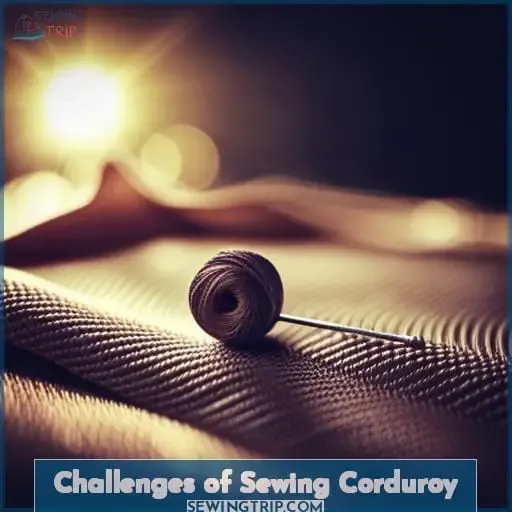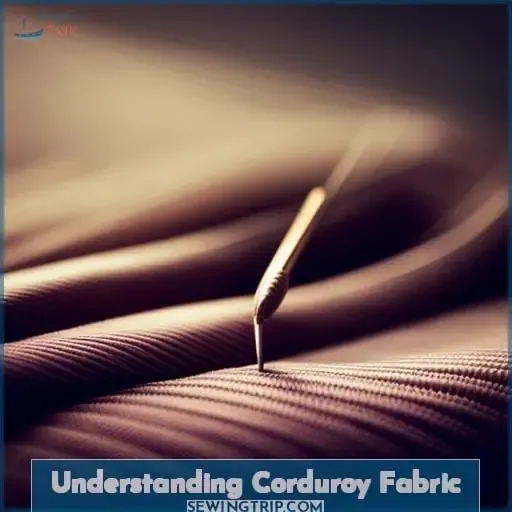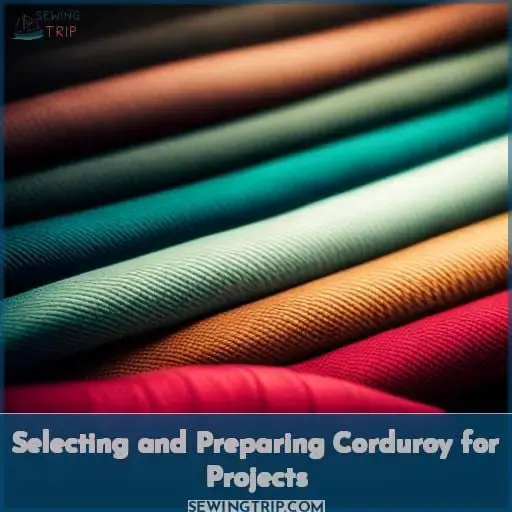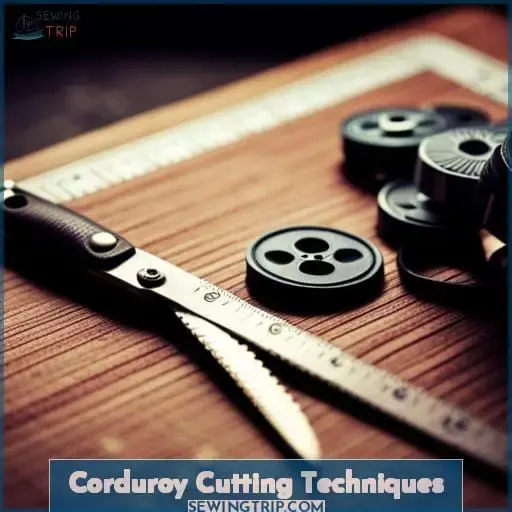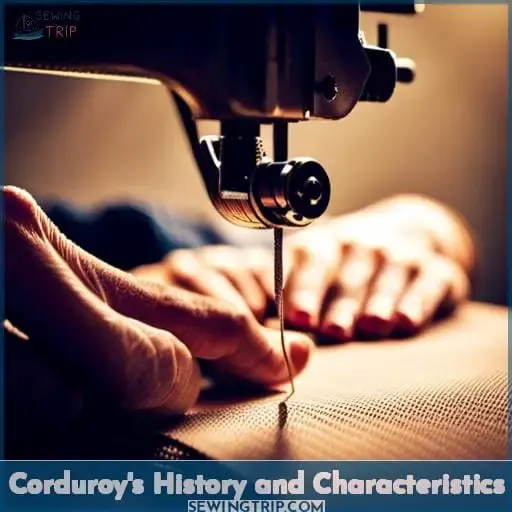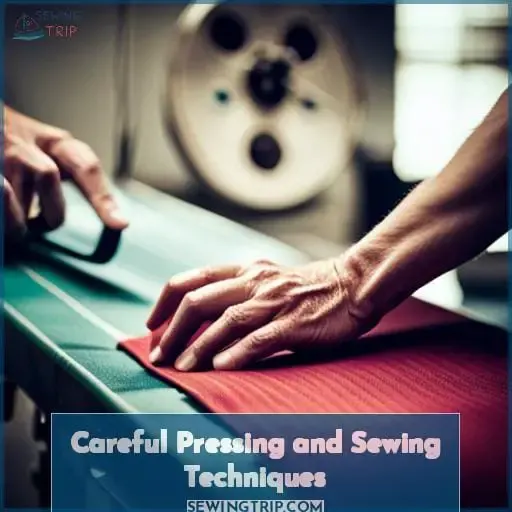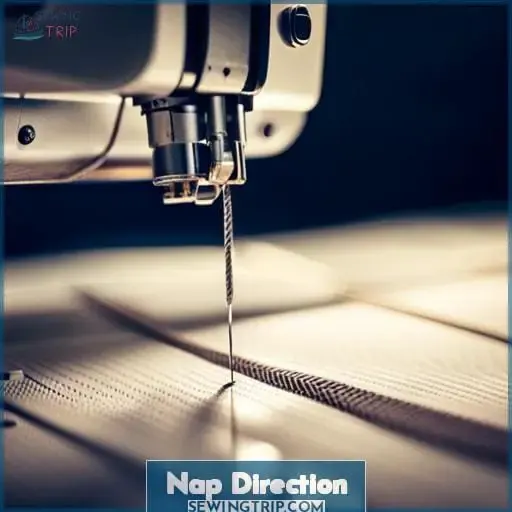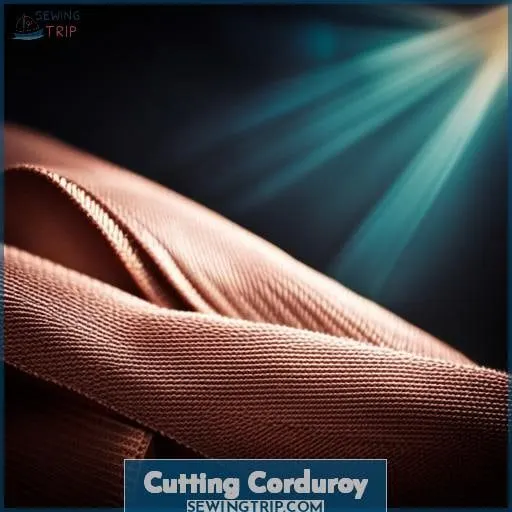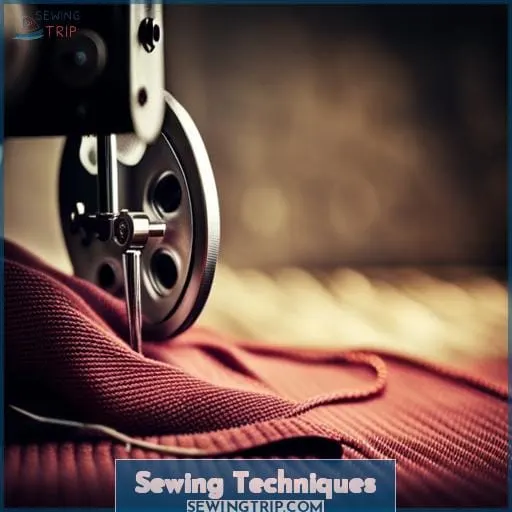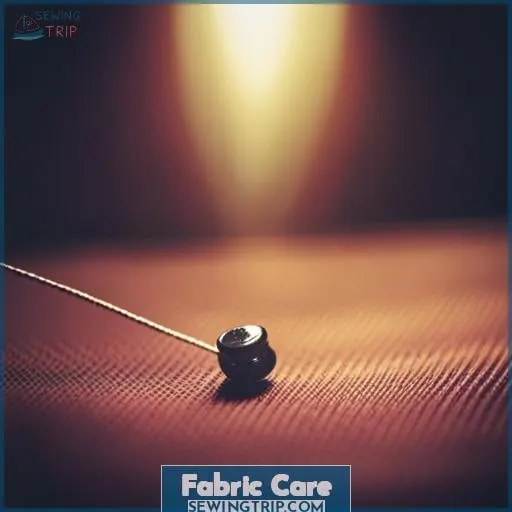This site is supported by our readers. We may earn a commission, at no cost to you, if you purchase through links.
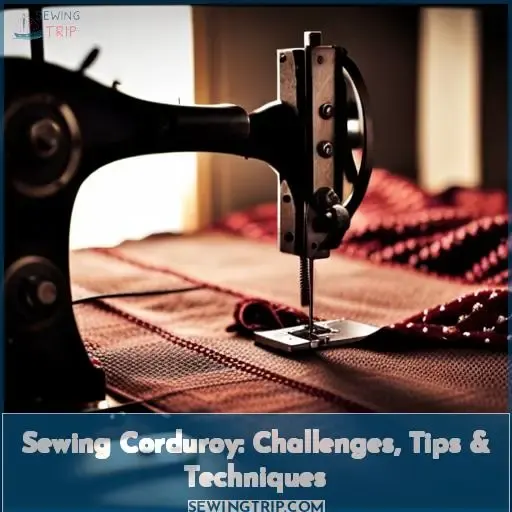 Imagine effortlessly sewing through corduroy fabric, creating beautiful garments that showcase your skills.
Imagine effortlessly sewing through corduroy fabric, creating beautiful garments that showcase your skills.
In this article, you will uncover the secrets of sewing corduroy: from understanding its unique characteristics to selecting and preparing the fabric for projects. Get ready to conquer those buttonholes and master the art of working with corduroy like a pro.
Say goodbye to frustration and hello to flawless stitching as you navigate through our tips and techniques for sewing corduroy.
Table Of Contents
- Key Takeaways
- Challenges of Sewing Corduroy
- Understanding Corduroy Fabric
- Selecting and Preparing Corduroy for Projects
- Corduroy Cutting Techniques
- Corduroy’s History and Characteristics
- Careful Pressing and Sewing Techniques
- Nap Direction
- Cutting Corduroy
- Sewing Techniques
- Fabric Care
- Frequently Asked Questions (FAQs)
- Conclusion
Key Takeaways
- Fabric compatibility is crucial when sewing corduroy; the unique ribbed sections may pose challenges compared to smooth fabrics.
- Maintenance and testing sewing machines properly is vital for them to function well with corduroy.
- Consider using solutions like tear-away stabilizers to help with tasks like buttonholes in thick corduroy fabric.
- Precisely cutting corduroy while carefully aligning the fabric grain is important for neatness when sewing.
Challenges of Sewing Corduroy
When sewing corduroy, you may encounter various challenges that require careful consideration and problem-solving.
Fabric compatibility is crucial, as different sections of the corduroy may present unique issues such as buttonhole difficulties on the fly section or variations in results on the lining lip.
Machine maintenance and testing are also important to ensure proper functioning, while considering fabric layers becomes essential for successful stitching.
As you navigate these challenges, experimenting with solutions like tear-away stabilizer or even contemplating manual buttonhole creation can help achieve desired outcomes without compromising overall dress quality.
Fabric Compatibility
When sewing corduroy, fabric compatibility is a key consideration.
Buttonhole challenges and issues with the corduroy fly can arise due to the unique texture of this fabric.
Stabilizer effectiveness should be evaluated when dealing with buttonholes on corduroy.
It may be necessary to explore a manual approach for creating buttonholes in order to maintain overall dress quality.
Understanding these challenges will ensure successful stitching and a well-crafted corduroy jacket.
Machine Maintenance and Testing
To address the challenges of sewing corduroy, prioritize machine maintenance and testing.
- Ensure needle selection is appropriate for the fabric thickness.
- Test buttonholes on scrap fabric to identify potential challenges with corduroy’s nap direction.
- Consider using stabilizers to minimize issues during buttonhole creation, but be aware of their potential impact on the fabric’s appearance and feel.
- If all else fails, consider a manual approach for creating buttonholes or addressing fly section issues.
Consideration of Fabric Layers
Challenges, Tips & Techniques’:
To successfully sew corduroy, it’s important to consider the multiple layers of fabric and their potential impact on your sewing process.
The fly section presents particular challenges with two corduroy layers plus the Hong Kong finished lining lip. While tear-away stabilizer was attempted, it worsened buttonhole issues and had varying effectiveness on different sections.
Careful evaluation of stabilizer use for specific layered areas is warranted to resolve problems without compromising the quality of the dress.
Attempted Solutions and Their Outcomes
Consequently, you’re often evaluating stabilizer effectiveness for specific layers.
A 3-step process helps assess options:
- Test stabilizer on scraps to check suitability and prevent damage.
- Analyze results of tests considering impacts on appearance.
- Select option balancing original goals with potential for compromising the fabric or overall quality.
Moving forward requires weighing precision desires against harm, aiming to uphold dress integrity without overvaluing one element.
Handmade Buttonhole Consideration
By considering creating the buttonholes on your corduroy garment by hand, you’re contemplating balancing your desire for precision with the fabric’s challenges. Sewing buttonholes in corduroy can be tricky due to its unique texture and thickness.
- Using a handsewn hem or a wash away stabilizer.
- Opting for a manual approach like the hand buttonhole stitch instead of machine-made ones.
Understanding Corduroy Fabric
Now that you have learned about the challenges of sewing corduroy, let’s dive into understanding this unique fabric. Corduroy isn’t your ordinary textile – it has a rich history and distinct characteristics that make it both intriguing and challenging to work with.
Here are three key aspects to grasp when dealing with corduroy fabric:
- Pile Direction: Before you start cutting, familiarize yourself with the pile direction by feeling the smooth and rough sides of the fabric. This will help determine how light interacts with its surface.
- Cutting Precision: To achieve impeccable results, cut corduroy carefully while keeping it on grain. Align pattern grainline arrows parallel to the wales (ribs) of the fabric for precise cutting.
- Sewing Neatness: Seam finishing is crucial in maintaining neatness when working with corduroy. Consider using a zigzag stitch or an overlocker for seam allowances to prevent fraying.
By grasping these essential elements, you’ll be well-equipped to handle this distinctive fabric in your sewing projects while paying homage to its historical significance as a durable yet fashionable material!
Selecting and Preparing Corduroy for Projects
When it comes to selecting and preparing corduroy for your sewing projects, there are a few key points to consider.
First, understanding the characteristics of corduroy fabric is essential in choosing the right weight and drape for your desired project.
Next, mastering cutting techniques that take into account nap direction and aligning pattern pieces with the wales will ensure precise results.
Lastly, implementing sewing tips such as sewing parallel to ribs and topstitching along them will give you professional-looking garments made from this unique fabric.
Corduroy fabric characteristics
When selecting and preparing corduroy for your sewing projects, it’s important to understand the characteristics of this unique fabric.
Corduroy has a distinct texture that adds depth and visual interest to your creations. Its weave structure consists of wales or ribs created by additional weft yarns on a plain or twill base fabric.
Corduroy also has historical significance as an affordable alternative to luxury fabrics, making it a versatile choice for various styling considerations.
Remember maintenance tips like nap layout, using sew-in interfacing with buttonholes, and employing invisible hems when working with stretch corduroy.
Cutting techniques for corduroy
You determine the nap direction of your corduroy fabric by feeling the smooth and rough sides before precisely cutting out all pattern pieces in the same direction.
- Align pattern grainline arrows parallel to fabric wales (ribs) for proper grain.
- Cut with the right side facing up to easily see and align vertical wales.
- Use the ribs as a guide to maintain straight cuts and prevent off-grain sewing.
- Pay attention to fold lines and vertical edges for precise cutting to preserve texture quality.
Sewing tips for corduroy
Employing proper sewing techniques preserves your corduroy’s texture and drape while constructing garments.
When sewing corduroy, opt for longer stitch lengths and lightweight threads to avoid compressing the fabric’s ribs.
Consider hand-basting zippers and other tricky areas first.
Use appliques, patches, embroidery and trim to embellish corduroy creatively.
Invest in quality needles and presser feet to achieve tailoring precision on this textured fabric.
Troubleshoot issues like play enforcement by adjusting tension, steam pressing lightly and using interfacing only when necessary.
Corduroy Cutting Techniques
To achieve precise and aligned cuts when working with corduroy, start by carefully cutting the fabric to keep it on grain.
Corduroy’s unique texture requires special attention to ensure its preservation during the cutting process.
Begin by aligning the pattern grainline arrows parallel to the fabric wales or ribs. This will help maintain proper nap direction and prevent any twisting in your finished garment.
When cutting, make sure to have the right side of the corduroy facing up so you can easily see and align with the ribs for precision cutting.
Pay close attention to fold lines and vertical edges as they’re crucial for maintaining straight cuts that followthe rib top stitching line accurately.
So be meticulous in your technique when dealing with this textured fabric, allowing you full mastery over your sewing projects from fit adjustments down-to-the-grain alignment!
Corduroy’s History and Characteristics
One notable aspect of corduroy is its rich history and unique characteristics.
Originated in 18th-century England, tracing back to Al-Fustat, Egypt
Theories on the name’s origin: Corderoy and corde du roi
Historically used as a budget-friendly alternative to luxury fabrics
Experienced resurgences in popularity during the 1970s and with ongoing shifts in fashion trends
Corduroy has a unique history, initially being cheaper than velvet but later valued for its sturdiness and texture. Key steps like singeing and brushing lead to the fabric’s signature ribbed pile formation.
While corduroy has seen fashion highs and lows, its current resurgence speaks to both its budget-friendly appeal and potential as a velvet alternative for sewing projects.
Careful Pressing and Sewing Techniques
Challenges, Tips & Techniques’:
When sewing corduroy, it’s important to handle the fabric with care and apply precise pressing and sewing techniques throughout the construction process.
To avoid damaging the textured surface, use steam when pressing rather than allowing the iron to sit directly on the fabric.
Align the wales properly when sewing vertical seams and topstitching to prevent a skewed appearance.
Lower the presser foot pressure and thread tension settings so as not to crush the fabric.
Sew with the pile running in one direction for consistency.
Taking these special precautions will result in a high-quality finished corduroy garment that maintains the integrity of this unique fabric.
Nap Direction
From careful pressing, assess the nap direction by feeling the smooth and rough sides of the corduroy.
Choose the pile direction based on personal preference, with the option to reverse it for a contemporary look.
Ensure all pattern pieces point in the same nap direction for consistency.
Carefully cut corduroy to keep it on grain.
Align pattern grainline arrows parallel to fabric wales (ribs).
Cut with the right side facing up to easily see and align with the ribs.
Pay attention to fold lines and vertical edges for precise cutting.
Use the ribs as a guide to maintain straight cuts and prevent off-grain sewing.
Sew vertical seams parallel to the ribs to avoid a twisted appearance.
Press wrong sides together on pieces with vertical seams for alignment.
Topstitch along the ribs for neat and straight results.
Cutting Corduroy
When cutting corduroy, carefully cut it to keep the fabric on grain.
Align the grainline arrows on your pattern pieces parallel to the fabric ribs for precision cutting.
Cut with the right side facing up to easily see and match the ribs, using them as guides for straight cuts.
Pay close attention to fold lines and vertical edges while cutting to maintain proper grain alignment.
For rib topstitching and seam pressing, line up the ribs wrong sides together first before stitching vertically along them.
With precise cutting and sewing techniques aligned to the pile direction, your corduroy creation made from cotton or polyester blend will have excellent drape reflecting textile history and the latest fashion trends.
Consider versatile patterns like skirts, trousers, or shirts to showcase corduroy’s uniqueness.
Sewing Techniques
Apply special sewing methods when working with corduroy to prevent fabric distortion.
To achieve precision stitching, ensure proper seam alignment by:
- Cutting corduroy on grain
- Aligning pattern pieces parallel to the ribs
When topstitching along the ribs, use a longer stitch length for wider wale corduroys to avoid compressing the pile.
Press with caution using pressing strategies that minimize crushing the ribs, such as:
- Using a light touch or steam without directly touching the fabric
- Employing a pressing cloth if necessary
Select an appropriate needle size for your machine to prevent skipped stitches and consider finishing seam allowances with zigzag stitch or overlocking to prevent fraying.
By following these sewing techniques and taking care of your garment through proper pressing, you can help ensure that your corduroy projects turn out beautifully.
Fabric Care
Lower your presser foot pressure and thread tension to prevent squishing the fabric.
Corduroy requires special care to preserve its ribbed texture and pile.
When it comes to ironing techniques, be gentle with corduroy. Use a pressing cloth if necessary to avoid crushing the ribs. Instead of applying direct heat, employ a light touch or utilize steam without touching the fabric for pressing.
Remember that corduroy is prone to pile compression, so lengthen your stitches when sewing wider wale corduroys in order to minimize this effect on the fabric’s appearance and durability.
By following these steps, you can ensure that your corduroy projects maintain their unique texture while also enhancing their longevity and overall visual appeal.
Frequently Asked Questions (FAQs)
What type of needle is best for sewing corduroy fabric?
Use a jeans/denim needle when sewing corduroy.
The sharp point can penetrate multiple fabric layers without damaging the ribs.
Size 90/14 or 100/16 work well.
Always change the needle if it starts to drag or damage the fabric.
Should I use a walking foot when sewing corduroy?
Yes, my dear, a walking foot is essential when sewing corduroy!
It prevents the layers from shifting around and smoothly feeds the thick fabric without mangling those luscious ribs.
Your stitching will be straight, precise, and beautifully smooth – perfectly showcasing corduroy’s sensuous texture in all its glory.
Simply glide that walking foot along and let it work its magic!
How can I prevent corduroy fabric from stretching as I sew it?
When sewing corduroy, stabilize your fabric’s grainline.
Clip and ease fuller sections to prevent stretching as you sew.
Employ fusible stay tape on curved seams for extra support.
Hand baste first if needed.
Take care not to tug excessively when sewing.
What stitch length should I use when sewing corduroy?
When sewing corduroy, select a longer stitch length to allow the fabric to move freely without compressing the pile.
Proceed slowly, letting the fabric feed itself through the machine to maintain the rib alignment.
With care, your corduroy creation will have crisp seams that enhance its character.
What thread tension and presser foot pressure settings work best with corduroy fabric?
Try a lower tension setting and light presser foot pressure when sewing corduroy.
Conclusion
So pull up that lush corduroy and get sewing!
By understanding the unique properties of this fabric and arming yourself with the right tools and techniques, you can fashion striking garments that will turn heads.
As you snip into that napped texture and guide your creation to completion, you’ll have conquered the challenges of sewing corduroy.
Wear your handcrafted corduroy pieces with pride and confidence, showcasing both the fabric and your skills at navigating its difficulties with flair.

